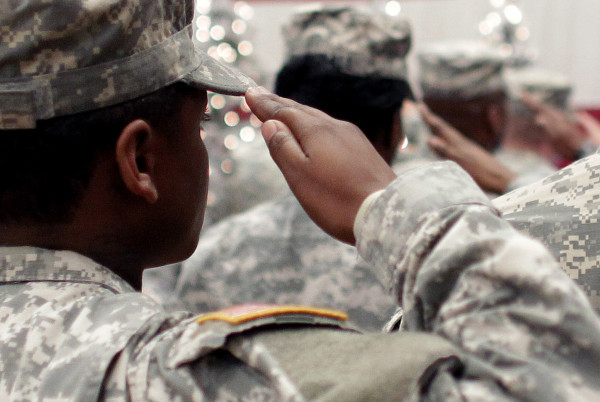

WASHINGTON — The Department of Veterans Affairs will hire 200 temporary workers and shell out $70 million to implement a major expansion of veterans’ education benefits — a process beset by communication and information technology challenges, veterans advocates and VA officials said Tuesday.
Higher-than-anticipated costs is one of a number of problems that the agency has faced for months of a yearlong charge to implement the “Forever” GI Bill, which contains 34 changes to veterans’ education benefits and boosts spending by $3 billion for 10 years.
VA officials, along with two organizations that advocated for the reformed GI Bill — Student Veterans of America and Tragedy Assistance Program for Survivors — went to Capitol Hill on Tuesday to update lawmakers on its implementation.
“It’s our job to identify and solve problems and have a smooth, cost-effective implementation,” said Rep. Jodey Arrington, R-Texas. “I do have concerns about the focus this is getting from VA senior leadership. I hope they understand it will be no small feat to execute a reform initiative of this scale.”
Advocates have called the Forever GI Bill the most sweeping expansion of veterans education benefits in a decade.
The bill, named the Harry W. Colmery Veterans Educational Assistance Act after the author of the original GI Bill of Rights, increases payments to vets with less than one year of active-duty service, restores benefits to veterans whose schools abruptly close, awards full GI Bill benefits to all Purple Heart recipients and increases aid for veterans pursuing science, technology, engineering and mathematics [STEM] degrees, among other things.
It was dubbed the Forever GI Bill by supporters because it ends a 15-year limit on education benefits for veterans whose last discharge or release from active duty came on or after Jan. 1, 2013.
The bill was signed into law Aug. 16, and most of its provisions go into effect Aug. 1, 2018.
Of the 34 measures in the bill, 22 require “significant changes” to the VA’s IT systems, said retired Maj. Gen. Robert Worley II, director of VA education services. The agency determined costs to program its IT systems to recognize the changes in benefits would cost about $70 million — an amount more than double the $30 million originally estimated for the task.
“We have major concerns on whether or not the office implementing this law is receiving adequate resources to execute this overhaul,” said Will Hubbard, vice president of Student Veterans of America.
Worley said the VA was in the process of hiring 200 temporary employees who would process claims by hand until the IT system is improved. A 40-to 50-person team will be responsible for deciding which veterans would be eligible for increased aid for STEM degrees.
Student Veterans of America led the charge to expand veterans’ education benefits and is watching closely as the VA carries it out, Hubbard said. Besides funding, the organization is also worried about the VA’s outreach efforts.
The GI Bill expansion included a mandate to restore education benefits to veterans and military families affected by school closures, such as the shutdown of for-profit ITT Technical Institute in 2016. The VA has reached out to 8,000 people who might be eligible to have their benefits restored. So far, 250 have applied, according to Worley’s testimony. A 27-person team – part of the VA’s hiring efforts — will determine which veterans are eligible.
“We’re concerned so few students have applied for restoration of benefits,” Hubbard said. “We encourage VA to partner with external organizations, like SVA, to reach out to widest audience possible.”
But Worley said it’s too early in the process to tell whether the outreach has worked. The VA sent the notifications Nov. 9.
“If we need more communication, we will do that,” Worley said. “I don’t know if it’s realistic to expect 8,000 applications.”
Portions of the Forever GI Bill went into effect this fall. TAPS, which is also involved in oversight of the bill’s implementation, discovered delays in payments to GI Bill beneficiaries.
“Even with the few changes that went into effect, TAPS had issues with institutions of higher learning demanding payment from the student because of delayed VA payments,” said Kathleen Moakler, director of TAPS. “Students receiving VA payments were not allowed to attend classes, register for spring 2018 or use campus facilities because the payment was delayed.”
TAPS also told lawmakers that the VA inappropriately distributed letters to some veterans informing them they were no longer eligible for education benefits because they had hit the 15-year limit. Because of the new law, that limit no longer applies to some veterans who received the letter.
Worley said the VA would send more letters telling those veterans to disregard the notice.
“This is why people have no faith in government,” said Rep. Kathleen Rice, D-N.Y. “You pass a historic piece of legislation, and the agency responsible for implementing it doesn’t have the tools to implement it. It’s so disappointing.”
Lawmakers will continue to receive periodic updates from the VA about the implementation process.
Worley and other VA officials present Tuesday said they were confident the expansion would be fully in place before the 2018 school year.
“In just under four months, VA has moved out quickly and is working hard on successfully implementing all of the provisions of the Colmery Act on time,” Worley said. “There is a great deal of work remaining, but VA has taken significant steps since the law’s signing.”
A full breakdown of changes to the GI Bill is available on the VA website at benefits.va.gov. and veterans can follow updates on its implementation at the VA’s Post-9/11 GI Bill Facebook page.
———
©2017 the Stars and Stripes
Distributed by Tribune Content Agency, LLC.